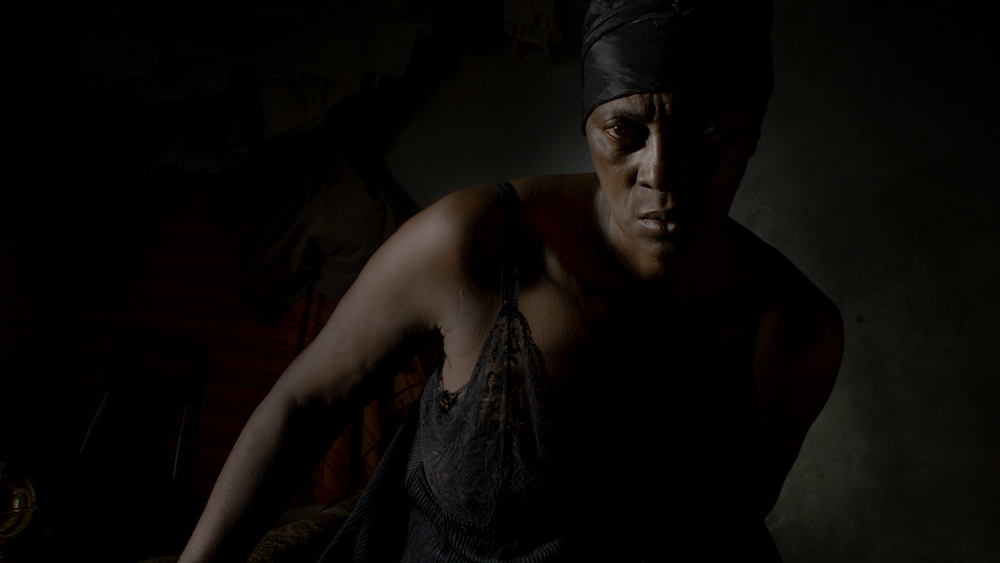Ghosts haunt all cities. In places like Berlin and Lisbon, modern buildings neighbor ancient ones and the cemeteries teem with centuries of spirits. In homes, laid in brick and mud, generations of families are born, and they die. Whether destroyed by revolution, war or disaster, even the forgotten silhouettes of a city’s past life inform the movement and identity of the city present. Human life seems finite in these conditions. Death, even unspoken, seems more present than life.
Against the backdrop of this crowded spiritual landscape, cities are often also a place of profound loneliness. As Olivia Chaing explains in her book The Lonely City, “You can be lonely anywhere, but there is a particular flavour to loneliness that comes from living in a city, surrounded by millions of people.”
This spring at BAM in NYC, a program built around Portuguese filmmaker Pedro Costa‘s newest film, “Vitalina Varela,” will explore Solitude on screen. Among the programmed films is Wim Wenders‘s “Wings of Desire,” one of the late-twentieth centuries last masterpieces.
Costa’s film, stark collaborative non-fiction, tells of the arrival of Cape Verdean immigrant Vitalina Varela shortly after the death of her estranged husband. She settles in his dark home, mourning; an unwelcome intruder in the neighborhood. While among Costa’s most accessible films, most of Vitalina unfolds in darkness, with only vague narrative elements. “Wings of Desire,” more fantastical and narrative-driven, was released in 1987 during the last years of the Berlin Wall. It is the story of angels, who overlook the city and its residents. One of the angels, Damiel (Bruno Ganz), falls in love and yearns to be human.
In “Vitalina Varela” and “Wings of Desire,” both filmmakers explore the nature of solitude and loneliness in their articulation of cityscapes.
As Vitalina lands in Portugal in the dead of night, she’s barefoot. She’s missed her husband’s funeral and finds herself in Cova da Moura, a Lisbon slum where many immigrants from the former African colonies have settled. In her new home, her husband’s living tomb, the sun barely shines through. Even in the day, the light that finds its way in glows with a putrid and gold ember.
“Wings of Desire” opens with a montage. We see Berlin from above, long before we ever touch foot to the ground. “My stories start with places, cities, landscapes and roads,” explains Wim Wenders in his book “The Logic of Images.” “To live in a city of undivided truth, to walk around with the invisible ghosts of the future and the past … ” A film in and about Berlin, our first images of the city, transform the familiar images of war; the perspective of war-planes turns into the gaze of angels. Angels, living outside the realm of human experience, see the world in grayscale.
The stories of Vitalina and Damiel are stories of outsiders.

I.
Writing about Wim Wenders’ film, “Alice in the Cities,” critic Adrian Martin qualified Wenders as a great portraitist of “the Half-Life Syndrome.” His films focused on “the withdrawn, detached, introspective, often indifferent life of an individual who simply drifts through landscapes and interpersonal situations.” In “Wings of Desire,” these outsiders are twofold; the angels who exist beyond the city and the residents who inhabit it.
After a millennia, Damiel wants to experience the world. If loneliness, as Olivia Chiang explains it, is “like being hungry when everyone around you is readying for a feast,” Damiel has never so much as tried a taste of bread or felt fresh water against his lips. He is stuck in a daze, a thick mist that obscures his relationship to the living. Even as he covets and collects humanity’s smallest miracles, Damiel has never had an opportunity to savor the preciousness of life firsthand.
Even as the people he watches are caught in their own mist, squeezed into anonymous and contemporary housing projects, all thinking of themselves alone in their rooms, the humans have room for growth and experience that Damiel as an outsider never will. Yet, Damiel’s ethereal nature also shields him with the oppressiveness of the Berlin Wall. Untethered by the material world, it is insignificant to him, as it crushes and redirects the citizens it inhabits: a deep scar on Berlin’s collective history.
In “Horse Money,” Pedro Costa’s previous film, he evoked Tourneur’s “I Walked with a Zombie” as a means of exploring the purgatorial fate of the African immigrants after Portugal’s 1974 revolution. The haze of Haiti’s zombie past, often thought of as a metaphor for the nation’s history of slavery and oppression, connect with Cape Verde’s history. Santiago, the island of Vitalina’s home, was once the second richest part of the Portuguese colony as an entry point of the transcontinental slave trade.
Vitalina was left by her husband forty years before when he left Cape Verde to start a new life in Lisbon. He promised to send her money to join him and never did. Vitalina was abandoned at home and transplanted to Lisbon, she remains alienated and lost. The ghosts of colonialism haunt Vitalina.
In her husband’s windowless home, she finds herself surrounded by men. They make it clear she is unwelcome: The house has no lock and a leaky roof; the lines between public and private life are blurred and threatened. “I’ve been waiting for my plane ticket to Portugal for 40 years. I’ll live here for the rest of my life,” Vitalina explains. Her need to stay, no doubt, a means of connecting with the ghosts of the past. As Vitalina tries to piece together the scraps of her husband’s life without her, and the fugue-state she experienced waiting for him, alone in her room, she whispers, “I don’t trust you living or dead.”
In an interview with Jordan Cronk for Film Comment (Jan-Feb 2020), Pedro Costa evokes a line from Chris Marker’s “Sans Soleil” describing Cape Verdeans. “How long have they been waiting for the boat? … A people of nothing, a people of emptiness, a vertical people.” Costa clarifies that this is the reality of women more than men, the ones left behind as their husbands went to the Portuguese mainland, forgetting them in the past.

II.
In “The Wizard of Oz,” as Dorothy steps into Oz for the first time, the film shifts from sepia to saturated Technicolor. A similar moment happens in “Wings of Desire,” as we shift for the first time, from the perspective of angels to humans; from overcast silver grayscale to the soft, warm, overwhelming colors of a circus. In the grey, the world is predictable, familiar and safe, even as tornadoes loom.
In grayscale, Berlin’s brutalist facade sculpts a city between life and death. The socialist projects of the city’s Eastern side, uniform and devoid of real life. The sun seems to rarely shine, the days existing in overcast perpetuity, indistinguishable from one another. Wenders shoots these images with the sparseness of a Paul Klee painting, deconstructing the city into its most integral spatial elements. Rather than see a portrait of the city as individualistic, it is a monolith. And, as every path leads back to the wall, there is a sense of the great cataclysmic divide. The wall, rather than act as the presence of rock and mortar, serves as an absence.
It’s only when Damiel first sees color, that he’s able to see the wall. He doesn’t see it as a division though but marvels at the graffitied faces that scale its exterior. He meets a stranger and asks about their colors, ignoring that they scale a guarded barrier. Shortly after that, we see the familiar (but now abandoned) grounds of the circus. A windowless building that was once anonymous is now painted with a full-color oasis. Perhaps just an illusion, but one that nonetheless offers hope and opportunity.
If “Wings of Desire” can be divided along the lines of color and gray, “Vitalina Varela” is a film of light and darkness.
“Vitalina Varela” unfolds almost exclusively at night and darkness fans the edges of the frame, extending the academy aspect ratio to encompass the negative space that surrounds it. The darkness feels thick with meaning, and its borders are ill-defined and spectral. Shot on location and with a small crew, most scenes have just a couple of light-sources meant to illuminate its subjects and to evoke, occasionally, a sense of labyrinthian depth. In this forgotten world of immigrants and drifters, the outcasts of society are rarely seen in the full light of day. The darkness evokes, what Roland Barthes wrote in his Mourning Diary, a “painful, lacerating,” absence.
Vitalina hardly blinks in the film, even as the camera holds her gaze for long-extended shots. Her eyes seem perpetually misty, even if she doesn’t cry. Sometimes, as the darkness deepens, the only thing that continues is the light of her eyes. Vitalina’s light shines from within, and even cast in mourning, the intensity of her presence extends outward as her suffering serves as a humanizing anchor in a landscape of ghosts. As she visits a priest in an abandoned chapel, Costa’s long-time collaborator Ventura, tells her, “Here we are, nobody.” In spite of her astronomical presence, socially speaking, her and other Cape Verdians are an absence.

III.
In the aftermath of the Second World War, Jacques Tourneur released “Berlin Express.” A rare Hollywood movie shot on location; the movie was made in the ruins of war-torn Frankfurt. The city was flattened; its buildings in ruins and its people dispirited. It was a film about pale reunions, a need for reconciliation between allied powers and the difficulties that would entail. It is also a movie about artificial borders and the power dynamics that emerge as lines are drawn.
Writing about the almost mystical presence of mushrooms in ruins in her book, The Mushroom at the End of the World: On the Possibility of Life in Capitalist Ruins, anthropologist Anna Tsing writes about the ghosts haunting the landscapes of Oregon. In this anonymous piece of land, people from all over the world descend to forage for the world’s most expensive fungi. The ghosts are the people who died searching but also the ghosts of war that haunt the refugees and veterans who make up a significant portion of the group. But, Tsing also writes of the ghosts of power, the invisible lines that draw and enact our “culturally layered enactment of freedom.”
“Wings of Desire”’s German title, “Der Himmel über Berlin,” translates directly to “The Sky Over Berlin.” “The sky is maybe the only thing that unites the two cities, apart from the past,” explains Wenders. The Berlin Wall, a visual and psychic presence, is the real protagonist of the film. As one character explains, “Berlin … in any case, you can’t get lost. You always end up at the Wall.” While the divide of the wall organizes East from West, one side having “measurably” more freedom than the other, both are hampered by its oppressiveness.
While some residents are acutely aware of this violence, such as an older man who wanders disoriented by its presence, most have no memory of life before the wall. Yet, they are no less disturbed by it. Studies have shown that people who live in proximity of walls suffer from Mauerkrankheit or “Wall Disease,” a term coined by Müller-Hegemann, a German psychiatrist observing the psychological trauma the Berlin Wall inflicted. In his patients, he found an increased level of psychosis, schizophrenia, and phobias. They were also more prone to rage, grief, and alcoholism and, the closer to the wall they lived, the more acute their symptoms.
The Berlin Wall, more than just a symbol of loneliness, becomes a source of it. But even decades after the wall was torn down, its effects remain: The “ghosts” of power are not so easily erased.
The fall of the Berlin Wall in 1989, two years after the release of “Wings of Desire,” marks one of the Twentieth Century’s later revolutions. Portugal’s Carnation Revolution, which took place in 1974, similarly happens during the contemporary era – late by European standards.
Pedro Costa was 13 in 1974. Costa talks about his long-time collaborator and friend, Ventura and their shared but disparate experience of the revolution. While Costa was in the streets shouting slogans and occupying factories, Ventura and his Cape Verdean comrades were afraid. The revolution did not free the Cape Verdeans; it entrapped them further. “For 20 years, he has been telling me stories of this prison – he calls it a prison. He fell into a deep sleep,” Costa told Cinemascope in 2014. As Neil Bahadur wrote in an astute analysis of Costa’s “Colossal Youth,” “The shift from fascist dictatorship to liberal democracy provided little to no difference to that of the poor.”
In “Wings of Desire,” Angels learned to speak by listening to humans do it; the spirits in Vitalina learned to speak from their oppressors. Vitalina, who only speaks in Creole, is told she must learn to speak Portuguese if she wishes to speak with her husband. A common thread in many colonized people, even long after “liberation,” the colonized have lost touch with their language and history. Their ancestors no longer speak their native tongue, they can only speak in the language of oppression. Even as Vitalina has come to join her husband’s spirit, she remains woefully alienated from it. The shadows of history remain long after walls and borders are torn down.
Is it any surprise that stories of cities are so often stories of ghosts? The experience of moving through city streets, along a wall or through a slum, echo with the past. Time, no longer experienced sequentially, exists in parallel as the past becomes an inescapable force shaping the present and future of its inhabitants.
Wim Wenders’ portrait of Berlin in “Wings of Desire” seeks to answer. He says, “One perennial question: How to Live?” It is a film of fleeting hopefulness in a world often gripped with solitude. It is a film where the empty spaces are occupied by angels who look out for us, urging us through brief interactions to look up at the sky, the way we once did as children.
“Vitalina Varela’s” insight might be more obscure but still suggests miraculousness. As Haden Guest writes in Cinemascope, Costa “understands and fervently believes in the potential of cinema to realize miracles onscreen – whether to cure infirmities of the body and soul, to bend the present to recover the past, or to calm the winds of the most savage storm.”
The visions of the Berlin Wall and Cova da Moura are entangled with history, haunted by ghosts of ancestors and spectres of power. They are, above all else, films that contain small miracles, perfect gestures of the body and soul.












